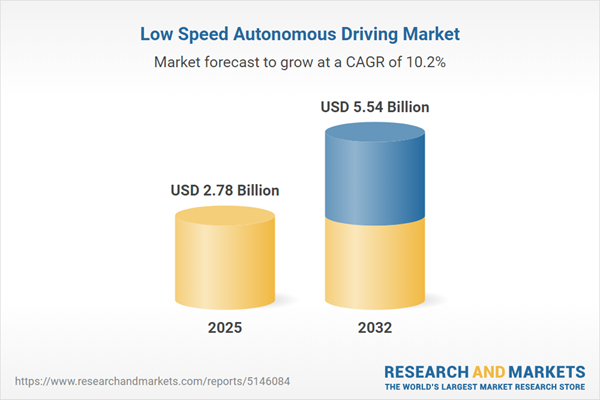Speak directly to the analyst to clarify any post sales queries you may have.
Low speed autonomous driving solutions are redefining enterprise operations by modernizing workflows and strengthening digital transformation strategies. Across industries, adopting these technologies helps organizations address compliance, safety, and productivity demands while adapting to evolving business models.
Market Snapshot: Low Speed Autonomous Driving Market Overview
The global low speed autonomous driving market achieved a value of USD 2.54 billion in 2024, with a projected compound annual growth rate of 10.23% through 2025. This growth is fueled by increased enterprise integration of artificial intelligence and sensor networks, bolstering operational safety and dependability. Sectors including agriculture, logistics, manufacturing, and public services are actively deploying these solutions to address stricter efficiency and compliance goals. As regulatory frameworks evolve globally, market participants are intensifying their strategies to support risk mitigation and automated adaptation, enabling sustained regional expansion.
Scope & Segmentation of the Low Speed Autonomous Driving Market
- Automation Grades: Covers partial to fully autonomous platforms designed to balance supervision needs with rigorous safety and regulatory requirements. Enterprises can customize solutions for low-speed, controlled areas or opt for higher autonomy within consistent, predefined environments.
- Core Components: Encompasses advanced connectivity, integrated cybersecurity, sophisticated control, and data management, along with intelligent path planning and decision-support systems. Sensor fusion technologies—including cameras, LiDAR, RADAR, and ultrasonic components—are supported by real-time safety management, system redundancy, and remote operations to ensure operational continuity.
- End User Sectors: Adoption spans a diverse range, including agriculture, airport ground support, vehicle assembly, hospitality, golf courses, retail, real estate management, logistics, e-commerce, and municipal use cases such as road and snow clearing, demonstrating broad adaptability across enterprise settings.
- Key Use-Cases: Includes site shuttles, last-mile delivery vehicles, campus fleets, industrial service platforms, and emerging robo-taxi applications. These deployments facilitate workflow automation and provide enterprises with greater operational flexibility.
- Geographic Regions: Strong market presence in the Americas, Europe, Middle East, Africa, and Asia-Pacific, with enhanced uptake in China, Japan, Germany, the United States, and the UAE. Emerging demand in Southeast Asia and Latin America is catalyzed by upgrades in digital infrastructure and progressive regulatory adaptation.
- Key Companies Analyzed: The report reviews strategies of major industry participants including Applied Electric Vehicles Ltd., Beijing Idriverplus Technology, Carteav Technologies, COAST AUTONOMOUS, Continental AG, EasyMile SAS, Magna International, Navya SA, Neolix Beijing, Nuro Inc., OTTO Motors (Rockwell Automation), Perrone Robotics, PIXMOVING, Polaris Inc., Ridecell, StreetDrone, Teijin Limited, Toyota Motor Corporation, UD Trucks (Isuzu Motors), Yamaha Motor Co., and ZMP Inc., highlighting their market positioning and collaborative networks.
Key Takeaways for Senior Decision-Makers
- Sensor networks combined with artificial intelligence strengthen safety processes, supporting compliance in increasingly regulated environments.
- Integrating autonomous solutions within workflows enables leaders in logistics and facility management to quickly adjust to changing workforce dynamics and site needs.
- Partnerships with technology vendors and regulatory institutions are essential for accelerating product introductions and ensuring alignment with local standards.
- Modular system architectures offer scalability, letting organizations tailor technology adoption to unique operational and geographical requirements.
- Robust supplier networks and collaborative technology partnerships underpin business resilience throughout the broader automation and digital evolution.
- Ongoing standardization and increased consolidation within the sector simplify procurement and increase agility across enterprise operations.
Tariff Impact on Supply Chains and Cost Structures
Recent changes in U.S. tariff policy have influenced supply chain decisions for low speed autonomous driving sector participants. Enterprises are responding with expanded domestic manufacturing investments, diversification of suppliers, and enhanced regional partnerships to reduce risks and maintain cost efficiency amid shifting global trade dynamics.
Methodology & Data Sources
This report leverages validated industry data, regulatory intelligence, and insights from sector experts. All findings are supported by a rigorous expert panel review, delivering actionable perspectives tailored for senior stakeholders exploring the low speed autonomous driving market.
Why This Report Matters
- Provides leadership teams with actionable market intelligence for competitive positioning and strategic growth.
- Supports operational teams with frameworks designed for compliance adaptation and process optimization as automation progresses.
- Enables transformation leaders to proactively manage supply chain continuity, risk, and digital integration in increasingly interconnected automation environments.
Conclusion
Decision-makers can use this report to navigate and capture value within the low speed autonomous driving market, fostering agile strategies and greater operational resilience for both current and future enterprise landscapes.
Additional Product Information:
- Purchase of this report includes 1 year online access with quarterly updates.
- This report can be updated on request. Please contact our Customer Experience team using the Ask a Question widget on our website.
Table of Contents
3. Executive Summary
4. Market Overview
7. Cumulative Impact of Artificial Intelligence 2025
Companies Mentioned
The companies profiled in this Low Speed Autonomous Driving market report include:- Applied Electric Vehicles Ltd.
- Beijing Idriverplus Technology Co. Ltd.
- Carteav Technologies Ltd.
- COAST AUTONOMOUS, INC
- Continental AG
- EasyMile SAS
- Magna International Inc.
- Navya, SA
- Neolix Beijing Technology Co., Ltd.
- Nuro, Inc.
- OTTO Motors by Rockwell Automation
- Perrone Robotics Inc.
- PIXMOVING,INC.
- Polaris Inc.
- Ridecell, Inc.
- StreetDrone, Inc.
- Teijin Limited
- Toyota Motor Corporation
- UD Trucks Corporation by Isuzu Motors Limited
- Yamaha Motor Co., Ltd.
- ZMP Inc.
Table Information
| Report Attribute | Details |
|---|---|
| No. of Pages | 185 |
| Published | November 2025 |
| Forecast Period | 2025 - 2032 |
| Estimated Market Value ( USD | $ 2.78 Billion |
| Forecasted Market Value ( USD | $ 5.54 Billion |
| Compound Annual Growth Rate | 10.2% |
| Regions Covered | Global |
| No. of Companies Mentioned | 22 |









